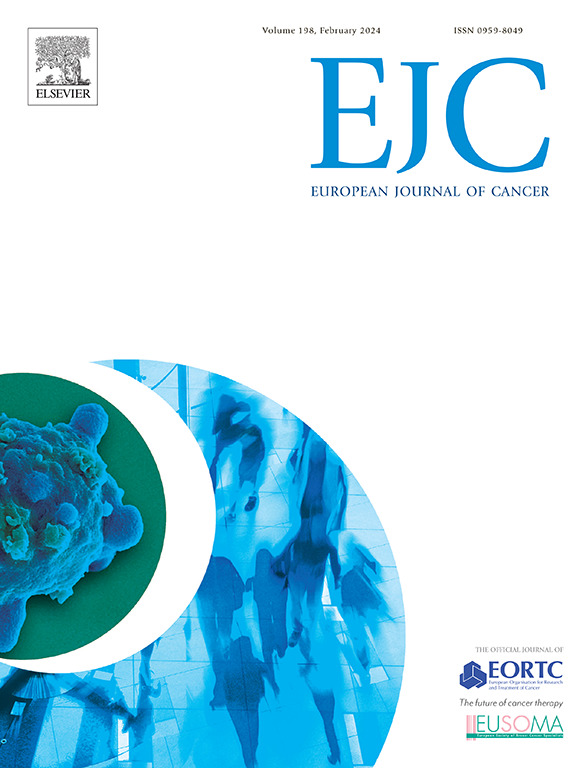Patterns of disease dissemination and survival in patients with synchronous and metachronous metastatic pancreatic adenocarcinoma: Nationwide population-based study
IF 7.6
1区 医学
Q1 ONCOLOGY
引用次数: 0
Abstract
Aim
Despite advances in understanding pancreatic adenocarcinoma, evidence on its metastatic patterns and impact on patient survival remains limited. This study aims to identify patterns of disease dissemination in synchronous versus metachronous metastatic pancreatic adenocarcinoma (mPAC) and their association with overall survival (OS).
Methods
Patients diagnosed with synchronous- or metachronous-mPAC were selected from the Netherlands Cancer Registry (2015–2021). Patient, tumor, and treatment characteristics were compared using Chi-squared tests. Survival data, calculated from detection of metastatic disease (OS-M), were analyzed using Kaplan-Meier and Log-rank tests.
Results
Overall, 10,788 patients with synchronous- and 508 with metachronous-mPAC were included. Median time to first metastasis in metachronous-mPAC was 13.2 months (IQR 9–23), varying significantly by metastatic site (liver-only 11.5; lung-only 28.0 months). Compared to synchronous-mPAC, patients with metachronous-mPAC had less liver metastases (48 % versus 75 %, p < 0.001), but more lung (29 % versus 21 %, p < 0.001) and peritoneal (35 % versus 25 %, p < 0.001) metastases. Synchronous metastases to liver-only, lung-only, lymph node-only, or multiple sites at first diagnosis had a median OS-M that was (nearly) half compared to metachronous metastases to the same sites. Bone-only or peritoneum-only metastases in synchronous-mPAC showed a median OS-M comparable to metachronous-mPAC.
Conclusion
This nationwide population-based study reveals that metachronous-mPAC less commonly presents with liver metastases and more often metastasizes to lung, peritoneum or other atypical sites compared to synchronous-mPAC. These distinct metastatic patterns and their differences in survival may help enhance the prognostic estimation for individual patients from the detection of metastatic disease and warrants further research into the biology underlying metastasis development.
同步转移性胰腺腺癌和间变性胰腺腺癌患者的疾病扩散模式和生存率:基于全国人口的研究
目的尽管对胰腺腺癌的认识有所进展,但关于其转移模式和对患者生存影响的证据仍然有限。本研究旨在确定同步与异时转移性胰腺腺癌(mPAC)的疾病传播模式及其与总生存期(OS)的关系。方法从荷兰癌症登记处(2015-2021)中选择诊断为同步或异时mpac的患者。采用卡方检验比较患者、肿瘤和治疗特征。通过检测转移性疾病(OS-M)计算的生存数据,使用Kaplan-Meier和Log-rank检验进行分析。结果共纳入同步mpac患者10788例,非同步mpac患者508例。异时性mpac患者首次转移的中位时间为13.2个月(IQR 9-23),不同转移部位差异显著(仅肝脏11.5个月;肺-仅28.0个月)。metachronous-mPAC患者synchronous-mPAC相比,减少了肝转移(48 %与75 % p & lt; 0.001),但更多的肺(29日21 %和% p & lt; 0.001)和腹膜(35 %和25 % p & lt; 0.001)转移。首次诊断时同步转移到肝脏、肺部、淋巴结或多个部位的患者,其OS-M的中位值(几乎)是同期转移到相同部位的患者的一半。同步mpac中骨转移或腹膜转移的中位OS-M与同步mpac相当。结论:这项基于全国人群的研究表明,与同时性mpac相比,异时性mpac较少出现肝脏转移,更常转移到肺、腹膜或其他非典型部位。这些不同的转移模式及其生存差异可能有助于从转移性疾病的检测中提高个体患者的预后估计,并值得进一步研究转移发展的生物学基础。
本文章由计算机程序翻译,如有差异,请以英文原文为准。
求助全文
约1分钟内获得全文
求助全文
来源期刊

European Journal of Cancer
医学-肿瘤学
CiteScore
11.50
自引率
4.80%
发文量
953
审稿时长
23 days
期刊介绍:
The European Journal of Cancer (EJC) serves as a comprehensive platform integrating preclinical, digital, translational, and clinical research across the spectrum of cancer. From epidemiology, carcinogenesis, and biology to groundbreaking innovations in cancer treatment and patient care, the journal covers a wide array of topics. We publish original research, reviews, previews, editorial comments, and correspondence, fostering dialogue and advancement in the fight against cancer. Join us in our mission to drive progress and improve outcomes in cancer research and patient care.
 求助内容:
求助内容: 应助结果提醒方式:
应助结果提醒方式:


